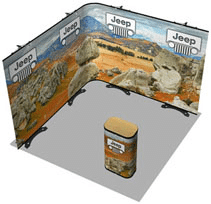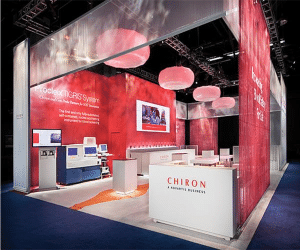Trade Show Displays: A Rose by Any Other Name
For those looking to expand their trade show displays, or even to start using them at their first show, the terminology used in the convention industry can sometimes be a barrier. Like in any specialized field, there are a lot of names used for various display stands and acessories in the trade show world you just don’t hear often anywhere else.
It’s even hard for companies like ours that sell trade show booths and supplies, because clients call up to request these displays by different names, and sometimes we need to compare pictures to understand what we’re both talking about!
So, for the newcomers, and all the rest of us too, we wanted to remind you of the most common and popular types of expo displays: what makes them different, and which are best for different situations when you’re setting up your own presentations.
A Quick Guide To The Various Kinds (and Names) Of Trade Show Displays
Pop Up Displays
Pop up displays are some of the mainstays of the trade show industry for their easy portability and setup. What makes them “pop up” is that they use collapsible accordion frames made of lightweight materials like aluminum, which expand out and collapse in within moments. Even large pop-up displays can be compressed into much smaller packages, suitable for transportation.
The original pop-up displays commonly used hooks, magnetic strips, or Velcro to attach roll-out fabric panels, which can be quickly put into place. This style of pop-up is still very popular, and there are dozens of slightly different designs from different manufacturers; the cream of the crop come with lifetime warranties.
The newest pop up display designs have evolved into even lighter-weight frames, using tension fabric panels instead of the heavier rolled graphic panels. The tension fabric graphics attach via buttons on the frames and button holes on the fabric graphics. (See the Xpression fabric displays here.)
Light weight popups can be somewhat more fragile, however, so extra care has to be taken with the booth itself. They also generally support less weight than heavier booths, so using them does limit your ability to hang heavy products. However, as a compromise between weight, price, and usability, pop up displays can be an excellent all-around choice.
Panel Displays
There are a wide variety of panel displays available, but their key distinguishing feature is that they’re built with solid panels rather than cloth. The panels are generally kept to lightweight materials like plywood or plastic, but because the panels are normally rigid – not compressible or rollable – in terms of shipping, they tend to need an extra shipping case, compared to other display stands.
On the other hand, panels do give an expo booth a very solid appearance, and can be a necessity for design styles meant to mimic a home or office environment. Plus, laminates and printing on solid materials are virtually always going to look – well, somewhat more solid, than on printed cloth.
Modularity is another important aspect here. Most panel displays are modular to some degree – meaning you can reconfigure the booth into different layouts. Modular trade show booths, by their very nature, encourage you to create designs from scratch. Modular-based booths tend to look a little boxy, because the building blocks are typically squares and rectangles. They’re good for playful designs, as well as more 3-dimensional layouts with plenty of surface space.
There are a couple of offshoots of the modular panel style of trade show displays, including the LITE panel system, the MultiQuad system, and the Euro LT modular laminate trade show booth. The LITE system is a completely tool-less system imported from Europe, and uses panels made from plastic and plastic connecting nodes to create many different shapes. The MQ system uses aluminum frames, and lightweight square magnetic graphic panels. The Euro LT uses lightweight laminated panels and clips – another tool-less system – and offers countless different choices in laminates. All three of these systems can be reconfigured into very different shapes and sizes, and the graphics can easily be changed as needed.
Truss Displays
As you might imagine, the distinguishing feature here is the use of reinforced trusses in the skeleton of the trade show display. Generally speaking, these are bulkier and heavier still, but can support a lot of weight if your booth design calls for a lot of hanging objects. We’ve also recently seen the introduction of composite truss systems – basically mimicing the design of steel and aluminum truss, but at a fraction of the weight.
The look of a truss trade show display is quite visually distinctive, and tends to give a booth something of an industrial or “street” quality, and can also be used to conjure up ideas of large crowd entertainment like sports and fashion shows.
The truss displays are also modular, and lend themselves to creative booth layout and design, since they’re built to be easily connected to one another. Laying them out often has a feel of playing with very large children’s construction toys, because that’s about how simple it is to connect them to each other. (And, hey, why not try to make setting up your display a little fun, right?)
Hybrid Tension Displays
Hybrid Tension Displays are the latest in trade show booth design ideas and technology. They’re hybrid because they may incorporate virtually any method into building their frames, and they’re tension because they rely on somewhat stretchy tension fabric graphics, which are held slightly taut in order to eliminate wrinkles.
In terms of looks, the sky’s the limit with hybrids. All manner of rounded display items are possible, where other methods tend towards hard angles. They can create freestanding towers and pedestals which are still relatively strong. When combined with internal lighting, they can get you a look that few others at an exposition can match.
However, it does come at a cost. These are usually among the most expensive off-the-shelf displays, mostly due to the more expensive cost of dye sublimation printing, so you’re paying for the extra exposure. Also, as fabric is a large part of their construction, they’re vulnerable to tearing. Make sure to keep sharp objects far away from them at all times.
Banner Stands
Banner stands are another of the mainstays – few trade show displays are without at least one or two. These freestanding units are designed to offer quick change displays, typically highlighting new products.
Like hybrids, banner stand construction can use a lot of different techniques, although collapsibility and easy transportation are major design concerns. There are retractable banner stands, which have a base that contains a coiled spring that winds up the banner graphic to protect it when not in use. There are also various X-stands and L-stands, named for the shape of their base.
All of these usually use lightweight, easily rolled fabrics for the banner display itself, adding to the portability. These banner graphics are normally printed using either inkjet printing on vinyl, or dye sublimation printing on fabric, processes that offer high quality graphics to maximize their clarity and visibility.
While they may be the main piece in a small show or impromptu presentation, banner stands are generally just accent pieces at a large trade show. They’re especially good for complementing or rounding out boxier designs made from modular display equipment. Recent banner stand designs add 3D and countoured shapes and even backlighting.
There are also a couple of recent product offerings that use banner stands to create full trade show back walls, including the Twist banner stand system. The Twist uses standalone banner stands with rollable graphics, and the individual banners can be attached together, in straight or curved lines, to create an endless graphic wall – they are designed to be single-sided or double sided, adding to their usefullness.
You Have Plenty Of Choices In Your Trade Show Displays
There are lots more trade show graphic display choices and names that we haven’t even touched: tabletop displays, trade show kiosks and counters, gazebos, custom carpets, literature racks, turntables, and more. However, most of these are familiar items and fairly easier to understand, compared to the complexities involved in comparing the larger trade show display structures covered above.
We invite you to check out our full line of expo displays and accessories, and let us know if you have any custom needs or specific questions – we’re always happy to help!
———-
You might also enjoy:
Seeing Exhibition Displays Through Your Visitors’ Eyes
